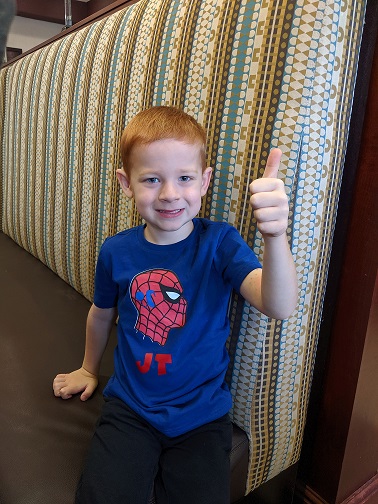Amanda M. looks back on her children’s experience with progressive hearing loss and her son’s journey to cochlear implants. After receiving bilateral cochlear implants, JT is progressing with speech recognition:
“When Ava Marie was born, she failed her newborn hearing test, but we were told that was common in a newborn born via C-section. When she was 1 month old, she passed and we were told everything was normal.
Around 10 months, Ava started to show signs of developmental delays. She started therapy around one year for physical therapy and occupational therapy as she was a late walker. When she was 3 years old, I took her to our school system to see if she qualified for extra services. She did not pass her right ear test during a hearing screening. Immediately after, we saw a few audiologists who did multiple booth tests, then a sedated auditory brainstem response test (ABR) to confirm a hearing loss diagnosis.
She initially got a hearing aid for her right ear, but her hearing loss quickly progressed, and she soon needed one for her left. Her hearing loss progressed monthly for about a year and has been stable ever since. All of that aside, she continued to have many medical issues and diagnoses. We have seen many specialists trying to confirm exactly what has caused all of them. Even after genetic testing, we still have no answer.
JT and his progressive hearing loss
 JT was born a couple years later and also failed his newborn screening due to fluid, but then passed when he was 1 month old. When he was 2, I began asking if we should have him tested as well. By the time he was 3, they thought he would be a bit more booth reliable. His testing showed a hearing loss in both ears, but we did a sedated ABR to confirm. He was quickly aided and used hearing aids. He had a much harder time acclimating to his hearing aids than Ava did.
JT was born a couple years later and also failed his newborn screening due to fluid, but then passed when he was 1 month old. When he was 2, I began asking if we should have him tested as well. By the time he was 3, they thought he would be a bit more booth reliable. His testing showed a hearing loss in both ears, but we did a sedated ABR to confirm. He was quickly aided and used hearing aids. He had a much harder time acclimating to his hearing aids than Ava did.
Unfortunately, his hearing loss continued to quickly progress and one and a half years later, he was possibly eligible for a cochlear implant in his right ear. In August of 2019, we were referred to our local children’s hospital and doctor to see if he qualified.
By the time we had those appointments, he was not only eligible for his right ear but also his left. That hearing loss happened in one month. The hospital was able to get him in for bilateral surgery very quickly, on October 17, and activation was set for November 11th.
Choosing Cochlear for JT
 Cochlear was an easy choice for us because we had friends who have two children with cochlear implants. Our friend’s children have different manufacturing companies and one child had Cochlear, while the other child had Med-El. Their mother preferred the ease of use of the Cochlear™ Nucleus® 7 Sound Processor over Med-El’s device. We also used their surgeon, at her recommendation.
Cochlear was an easy choice for us because we had friends who have two children with cochlear implants. Our friend’s children have different manufacturing companies and one child had Cochlear, while the other child had Med-El. Their mother preferred the ease of use of the Cochlear™ Nucleus® 7 Sound Processor over Med-El’s device. We also used their surgeon, at her recommendation.
So far, we have had seven trips to the audiologist and four mapping appointments, and JT has made tremendous progress! He’s working his way up to more speech recognition but making significant progress. I really love the easiness of the Nucleus Smart App1 being able to control his sound processors directly from it. He also loves the Bluetooth®2 capabilities for his iPad®3. I truly think that Cochlear’s devices will change his life for the better!! Now and in the future.
We continue to not know the cause of both of our children’s loss as all genetic testing and scans came back negative. They think our gene just hasn’t been found yet. So, we will continue to deal with the day to day and be thankful for our children’s hearing devices, which have given them back the gift of hearing.”
Was your child diagnosed with a progressive hearing loss? Learn more about cochlear implants today.
- For information on sound processor and app compatibility, visit www.cochlear.com/compatibility
- The Bluetooth® word mark and logos are registered trademarks owned by Bluetooth SIG, Inc. and any use of such marks by Cochlear is under license.
- iPad is a trademark of Apple Inc., registered in the U.S. and other countries.
